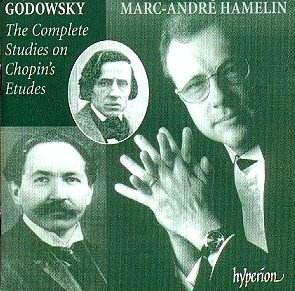Leopold GODOWSKY: Studies on Chopin's Etudes
(complete)
 Marc-Andre Hamelin
(piano)
Marc-Andre Hamelin
(piano)
 HYPERION CDA67411/2
(2 CDs) [153' 02"]
HYPERION CDA67411/2
(2 CDs) [153' 02"]

Taking as his starting point Chopin's two sets of Etudes (Opp. 10 & 25)
and the Trois Nouvelles Etudes, Godowsky, in order to "further the art of
pianoforte playing," contrived several versions of each Chopin Etude (except
Op.25/7) elaborated both musically and technically. Polish-born (like Chopin)
Godowsky (1870-1938) divides opinion regarding his Studies on Chopin's Etudes.
It depends, I suppose, how offended you are with his re-workings. As a pianist
himself he was arranging the Etudes from his own experience of studying and
playing them; as far as I can see his intentions were sincere and laudable.
In order to fully appreciate what Godowsky has done it is important to know
the Chopin originals (some of the greatest piano music). However, even if
you are not familiar with Chopin's inspired creations as he wrote them,
Godowsky's commentaries on them retain (to a greater or lesser extent) Chopin's
melodies - each can be appreciated on purely musical terms as a Chopin/Godowsky
collaboration. And there are some real gems here to complement what Chopin
left us.
That this is so is due to Hamelin. Whatever difficulties the pianist faces
(and they are considerable), Hamelin has overcome them and is able to play
each of Godowsky's Studies as a musical entity. It says much for Chopin's
genius - and Godowsky's imagination - that it was possible, for example,
for Godowsky to write seven Studies based on Chopin's Op.10/5. Each has a
different character but Chopin's original is omnipresent: it's like viewing
the same object from various angles and seeing a different (but related)
perspective.
Hyperion's booklet is a model of how to present music that isn't heavily
represented in the catalogue or, in this case, only known to piano cognoscenti.
Godowsky's own introduction is included along with an essay by Jeremy Nicholas
(an author on Godowsky) and comments by Hamelin himself. Add the top-notch
production values of Andrew Keener and superb Tony Faulkner sound and this
release cannot be faulted. I did wonder though if Hyperion has missed a trick
by not adding a third CD and asking Hamelin to record Chopin's 27 Etudes
as well - a complete package.
As someone who has known and loved Chopin's Etudes for many years I appreciate
what Godowsky has done. He has illuminated and extended the originals' scope
both in revealing how much more music can be found in Chopin's masterpieces
while designing a feast of technical challenges that very few pianists can
fully aspire to. Hamelin is one such. He has no doubt achieved miracles of
pianistic wizardry in preparing these 54 pieces. The biggest compliment I
can pay him is to report that each of Godowsky's Studies comes to life as
a piece of music on its own terms - and each can be enjoyed as such.
Reviewer
Colin Anderson

